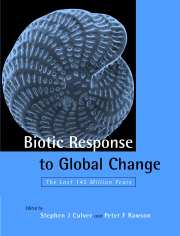Book contents
- Frontmatter
- Contents
- List of contributors
- Preface
- 1 Introduction
- 2 The Cretaceous world
- 3 The Cenozoic world
- 4 Calcareous nannoplankton and global climate change
- 5 Phenotypic response of foraminifera to episodes of global environmental change
- 6 The response of planktonic foraminifera to the Late Pliocene intensification of Northern Hemisphere glaciation
- 7 The response of Cretaceous cephalopods to global change
- 8 Global change and the fossil fish record: the relevance of systematics
- 9 Response of shallow water foraminiferal palaeocommunities to global and regional environmental change
- 10 Intrinsic and extrinsic controls on the diversification of the Bivalvia
- 11 Global events and biotic interaction as controls on the evolution of gastropods
- 12 Algal symbiosis, and the collapse and recovery of reef communities: Lazarus corals across the K–T boundary
- 13 Changes in the diversity, taxic composition and life-history patterns of echinoids over the past 145 million years
- 14 Origin of the modern bryozoan fauna
- 15 Angiosperm diversification and Cretaceous environmental change
- 16 Cenozoic evolution of modern plant communities and vegetation
- 17 Leaf physiognomy and climate change
- 18 Biotic response to Late Quaternary global change – the pollen record: a case study from the Upper Thames Valley, England
- 19 The Cretaceous and Cenozoic record of insects (Hexapoda) with regard to global change
- 20 The palaeoclimatological significance of Late Cenozoic Coleoptera: familiar species in very unfamiliar circumstances
- 21 Amphibians, reptiles and birds: a biogeographical review
- 22 Paleogene mammals: crises and ecological change
- 23 Response of Old World terrestrial vertebrate biotas to Neogene climate change
- 24 Mammalian response to global change in the later Quaternary of the British Isles
- 25 Human evolution: how an African primate became global
- 26 The biotic response to global change: a summary
- References
- Index
22 - Paleogene mammals: crises and ecological change
Published online by Cambridge University Press: 14 August 2009
- Frontmatter
- Contents
- List of contributors
- Preface
- 1 Introduction
- 2 The Cretaceous world
- 3 The Cenozoic world
- 4 Calcareous nannoplankton and global climate change
- 5 Phenotypic response of foraminifera to episodes of global environmental change
- 6 The response of planktonic foraminifera to the Late Pliocene intensification of Northern Hemisphere glaciation
- 7 The response of Cretaceous cephalopods to global change
- 8 Global change and the fossil fish record: the relevance of systematics
- 9 Response of shallow water foraminiferal palaeocommunities to global and regional environmental change
- 10 Intrinsic and extrinsic controls on the diversification of the Bivalvia
- 11 Global events and biotic interaction as controls on the evolution of gastropods
- 12 Algal symbiosis, and the collapse and recovery of reef communities: Lazarus corals across the K–T boundary
- 13 Changes in the diversity, taxic composition and life-history patterns of echinoids over the past 145 million years
- 14 Origin of the modern bryozoan fauna
- 15 Angiosperm diversification and Cretaceous environmental change
- 16 Cenozoic evolution of modern plant communities and vegetation
- 17 Leaf physiognomy and climate change
- 18 Biotic response to Late Quaternary global change – the pollen record: a case study from the Upper Thames Valley, England
- 19 The Cretaceous and Cenozoic record of insects (Hexapoda) with regard to global change
- 20 The palaeoclimatological significance of Late Cenozoic Coleoptera: familiar species in very unfamiliar circumstances
- 21 Amphibians, reptiles and birds: a biogeographical review
- 22 Paleogene mammals: crises and ecological change
- 23 Response of Old World terrestrial vertebrate biotas to Neogene climate change
- 24 Mammalian response to global change in the later Quaternary of the British Isles
- 25 Human evolution: how an African primate became global
- 26 The biotic response to global change: a summary
- References
- Index
Summary
INTRODUCTION
The distribution and evolution of mammals over the past 145 million years show an interesting diversity of patterns. The two main physical parameters that appear to have controlled these patterns are the presence or absence of land bridges between land masses and climate change. A catastrophic event, possibly resulting from either volcanism or extraterrestrial impact, may also have played a part. Emergence of a land bridge may be the result of local tectonic uplift, but more widespread land corridors can be created by eustatic lowering of sea level. Climate change is a critical factor in the latitudinal movement of vegetation zones and in shortening or lengthening the annual period of food availability. Mammals have responded to these parameters of global change by evolving new ecological strategies and/or by shifting their geographical ranges. Long-term climate changes affecting annual ranges of temperature and thus determining seasonality vs. equability may be an important cause of community evolution (Janis, 1989; Collinson & Hooker, 1987, 1991). The absence of land connections may prevent or inhibit geographical range extensions and cause widespread endemism (vicariance). An example of this is the independent evolution of several now extinct mammalian orders in the Tertiary of South America, which until the Late Pliocene was an island continent (Pascual et al., 1985). The effects of tectonics and climate are thus closely linked, but their variable interrelationships may be expected to produce different faunal patterns in the geological record, which are capable of interpretation.
- Type
- Chapter
- Information
- Biotic Response to Global ChangeThe Last 145 Million Years, pp. 333 - 349Publisher: Cambridge University PressPrint publication year: 2000
- 14
- Cited by

